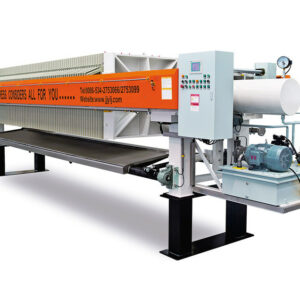Filter press leakage can occur for several reasons, and addressing the root cause is important to prevent further damage to the filter press and to ensure optimal performance.
Here are some common causes of filter press leakage:
Damaged or worn gaskets: Gaskets are used to create a seal between the plates and prevent leakage. Over time, gaskets can become damaged or worn, resulting in leakage. Regular inspection and replacement of gaskets can help prevent leakage.
Cracked or damaged plates: Cracks or damage to the filter press plates can cause leakage. It is important to inspect the plates regularly and replace any damaged or worn plates promptly.
Improperly tightened bolts: Bolts that hold the plates together need to be properly tightened to prevent leakage. If the bolts are not tightened properly, leakage can occur. Regular inspection and tightening of bolts can help prevent leakage.
Clogged or damaged filter cloths: Clogged or damaged filter cloths can cause pressure buildup and leakage. Regular inspection and replacement of filter cloths can help prevent leakage.
Damaged hydraulic hoses or seals: Hydraulic hoses and seals can become damaged over time, causing leakage. Regular inspection and replacement of hydraulic hoses and seals can help prevent leakage.
Improperly aligned plates: If the plates are not properly aligned, leakage can occur. It is important to ensure that the plates are properly aligned during assembly to prevent leakage.
Overloading of the filter press: Overloading the filter press beyond its capacity can cause excessive pressure and strain, Filter press for sale leading to leakage. It is important to ensure that the filter press is operated within its capacity to prevent leakage.
It is important to address the root cause of filter press leakage promptly to prevent further damage to the filter press and to ensure optimal performance. Regular inspection and maintenance can help identify potential issues before they become more serious.
Can you recommend a maintenance schedule for the filter press?
A maintenance schedule for a filter press will depend on several factors, including the specific type of filter press, the operating conditions, and the frequency of use. Here is a general maintenance schedule that can be used as a guideline:
Daily:
Check the filter press for any signs of leakage, damage, or wear.
Clean the filter press and remove any debris or contaminants.
Check the hydraulic system for proper operation.
Weekly:
Inspect the filter cloths or screens for wear or damage, and replace as needed.
Check the hydraulic hoses and fittings for leaks, and replace as needed.
Lubricate the filter press components as recommended by the manufacturer.
Monthly:
Inspect the plates for cracks or damage, and replace as needed.
Test the pressure gauge for accuracy, and calibrate if necessary.
Check the filter press for proper alignment, and adjust as needed.
Quarterly:
Perform a full inspection of the filter press, including all components and systems.
Test the filter press for proper operation and performance under load.
Annually:
Replace all gaskets and seals.
Replace the hydraulic fluid and filters.
Perform a full maintenance service, including all recommended maintenance procedures.
It is important to consult with the manufacturer’s recommendations and guidelines for the specific filter press to ensure that the maintenance schedule is appropriate for the specific application and requirements. Regular maintenance can help extend the life of the filter press and prevent costly downtime and repairs.
